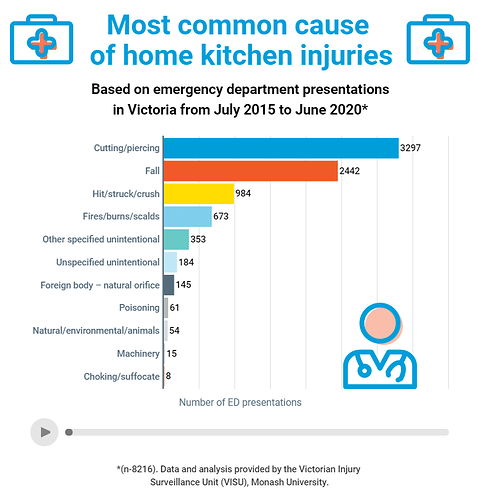Here are some safety tips to help you avoid common cooking injuries:
I can well understand the “top marks” for cutting / piercing. A few years ago, I had a set of knives sharpened and was using one of them to cut up cooked chicken for sandwiches. A moment of inattention and I had to drive myself to the emergency room with my finger wrapped in a tea towel. I’ll spare the details.
Keep those fingers clear!
I was badly cut (to the bone on my pointing finger) when I was a teenager - put my hahd in a fishing creel and happened to grab a razor sharp filleting knife at the same time. We learnt the importance of a knife sheath and now try to buy knifes with them when we buy new ones. Even storing in the kitchen poses risks unless they are in sheaths (block or slide on sheath). Can’t understand why all sharp knives aren’t sold with them.
I was interested in the comments about burning and scalding. Has anyone else noticed that many free standing cookers have their controls at the back of the stove. This is just a mad design as far as I am concerned. Reaching over a pot or pan of anything that is cooking to turn it off is just asking for trouble, I’ll never have a cooker like that.
Those with controls at the front are a recipe for accidents when children are around. Controls placed to the side seem a better safety design to me to avoid many risks of other placement areas.
It was good to see such good advice on avoiding knife injuries. I meet people who are afraid of sharp knives who are a hazard to themselves and in some cases to the children they teach bad habits to. The rules for beginning cooks are very simple:
- keep your blade sharp and keep your knife handle and hands dry,
- cut downwards on to a cutting board, not on the bench, not up in the air, not any odd angle, turn the food not the blade,
- do not put your holding hand under the blade.
If you stick to those rules you cannot cut yourself. There will be a few things you can’t do but start that way to teach children.
Once you have mastered that much you can go on to slightly more risky cuts like horizontal cuts to produce thin fillets (eg for schnitzel) out of thicker cuts. In this case your holding palm is flat on top of the slice while you guide the blade parallel to the board. Even that risk can be skipped by making your thin slices out of chunk not a thick slice. The trick is to partially freeze the chunk and slice down off one end.
While we on about cutting chunks into slices always cut across the grain of the meat if you can, it will be more tender. The obvious example is a chunk of corned beef like silverside. Such cuts of meat are often fairly tough and take long cooking but even then they can be stringy if cut along the grain.
I might add this is much easier if your working knife fits your hand. You can get general purpose ‘chef’s knives’ in many sizes. Both the handle and the weight of the knife have to fit you. Don’t buy a knife without testing the balance, it should feel good like an extension of your hand. For those with medium to large hands a 20 cm blade is usually right, but if you have small hands (or your child does) try a 15 cm. A 25 or even 30 cm blade may look macho but is rarely the right choice unless you need the length for long slices or grow huge pumpkins. Get the right knife and it will last your lifetime and become an heirloom worth handing down.
Absolutely, but you try to find that in a 54cm upright.
I agree but shouldn’t that become a standard of how to produce these? They build things to a price and where they can get their best bang for buck and often Child or User safety are at best secondary thoughts.
